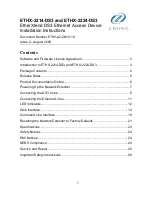
Chapter 7 Networking
LTE7460-M608 User’s Guide
79
Global/local denotes the IP address of a host in a packet as the packet traverses a router, for example,
the local address refers to the IP address of a host when the packet is in the local network, while the
global address refers to the IP address of the host when the same packet is traveling in the WAN side.
Note that inside/outside refers to the location of a host, while global/local refers to the IP address of a
host used in a packet. Thus, an inside local address (ILA) is the IP address of an inside host in a packet
when the packet is still in the local network, while an inside global address (IGA) is the IP address of the
same inside host when the packet is on the WAN side. The following table summarizes this information.
NAT never changes the IP address (either local or global) of an outside host.
What NAT Does
In the simplest form, NAT changes the source IP address in a packet received from a subscriber (the
inside local address) to another (the inside global address) before forwarding the packet to the WAN
side. When the response comes back, NAT translates the destination address (the inside global address)
back to the inside local address before forwarding it to the original inside host. Note that the IP address
(either local or global) of an outside host is never changed.
The global IP addresses for the inside hosts can be either static or dynamically assigned by the ISP. In
addition, you can designate servers, for example, a web server and a Telnet server, on your local
network and make them accessible to the outside world. If you do not define any servers, NAT offers the
additional benefit of firewall protection. With no servers defined, your LTE7460-M608 filters out all
incoming inquiries, thus preventing intruders from probing your network. For more information on IP
address translation, refer to
RFC 1631
,
The IP Network Address Translator (NAT)
.
How NAT Works
Each packet has two addresses – a source address and a destination address. For outgoing packets,
the ILA (Inside Local Address) is the source address on the LAN, and the IGA (Inside Global Address) is
the source address on the WAN. For incoming packets, the ILA is the destination address on the LAN,
and the IGA is the destination address on the WAN. NAT maps private (local) IP addresses to globally
unique ones required for communication with hosts on other networks. It replaces the original IP source
address (and TCP or UDP source port numbers for Many-to-One and Many-to-Many Overload NAT
mapping) in each packet and then forwards it to the Internet. The LTE7460-M608 keeps track of the
original addresses and port numbers so incoming reply packets can have their original values restored.
The following figure illustrates this.
Table 30 NAT Definitions
ITEM
DESCRIPTION
Inside
This refers to the host on the LAN.
Outside
This refers to the host on the WAN.
Local
This refers to the packet address (source or destination) as the packet travels on the
LAN.
Global
This refers to the packet address (source or destination) as the packet travels on the
WAN.
Содержание LTE7460-M608
Страница 8: ...8 PART I User s Guide...
Страница 23: ...23 PART II Technical Reference...
Страница 56: ...Chapter 6 Home Network LTE7460 M608 User s Guide 56 Figure 43 Change advanced sharing settings...
Страница 84: ...Chapter 7 Networking LTE7460 M608 User s Guide 84...
Страница 118: ...Appendix B Legal Information LTE7460 M608 User s Guide 118 Environmental Product Declaration...
















































